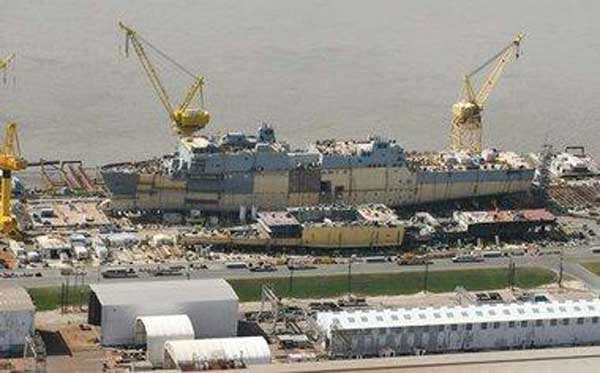By Vince Martinez
08/23/2011 – As the shipbuilding industry prepares for an uncertain future, the looming closure of the Avondale Shipyard near New Orleans expected sometime in 2013 is a clear reminder of the impacts of the downturned economy and a future of fiscal uncertainty.
Such corporate decisions are the direct result of a minimized demand for ship construction, and outlines a strategy on the industry side to consolidate their production capacity to better answer the demand signals coming from the Department of Defense (DoD).

Credit: http://photos.nola.com/tpphotos/2010/07/avondale_shipyard_closing_in_2_5.html
Anyone who has been paying attention to the economic challenges the state of Louisiana is facing — especially after Katrina and the after affects of the oil spill in the Gulf of Mexico — knows full well that the last thing that region needs is an exponential loss of jobs that are the direct result of an overall reduction in shipbuilding demand.
Though the impacts on the regional economy surrounding Avondale are obvious and unfortunate, what is more troubling is the fact that the U.S. seems to be content with losing its flexibility in terms of overall shipbuilding infrastructure. Much like we have seen in the aviation industry following the a dramatic downturn in production starting as early as the close of World War II, this is a troubling sign that the shipbuilding industry is following the same pattern of being reduced to a handful of vendors that are capable of designing, producing and fielding the ships needed to maintain our national security.
What DoD and Congress have to collectively acknowledge, however, is that once those companies, sites and jobs disappear — along with the years of expertise and experience associated with them — vendor choice dries up significantly, and affordable, viable competition for building ships will likely never return without an exponential higher cost and the associated programmatic risk. You don’t have to look at this from the strategic level, however, to understand the impacts of this decision on the future posture of the nation’s shipbuilding industry.
Case in point: A colleague was down in New Orleans recently and stopped by a local casino to play a few hands. He ended up in a discussion with a card dealer who was once a welder at the Avondale shipyard who had ultimately lost his job. While you have to applaud the former welder’s drive to support his family, you don’t have to be a shipbuilder to note that the skill set for both jobs are completely different.
In the conversation, the former welder also voiced his frustration with the uncertainty of the shipbuilding industry in the region. It is likely that type of uncertainty will keep him, and others who have migrated away from the shipyard, from walking away from new and likely more stable roots if given the opportunity.
It also illustrates that once this type of expertise walks away, it will be exponentially harder to attract them back into the fold without placing themselves or their families at significant risk.
Additionally — and what is often lost on many — once you lose those experts and the jobs that feed them, you also lose the training ground for developing the next generation of shipbuilders — much of which has been largely responsible for the economic stability of that region.
 The Navy says that the 700-foot amphibious transport vessels built at Avondale Shipyard by Northrop Grumman are getting more reliable. (Credit: http://www.nola.com/politics/index.ssf/2011/03/avondale_shipyard_vessels_gett.html)
The Navy says that the 700-foot amphibious transport vessels built at Avondale Shipyard by Northrop Grumman are getting more reliable. (Credit: http://www.nola.com/politics/index.ssf/2011/03/avondale_shipyard_vessels_gett.html)
The most unfortunate part about this particular exchange, however, is that it appears that the former shipyard subject matter expert seems to think that gambling is far more stable than shipbuilding is in New Orleans these days — and you can’t really blame him for coming to that conclusion.
While it may be easy to justify cutting shipbuilding costs as a result of an often detached, cubical-based budget drill in Washington, D.C., it is up to Congress and the senior leadership within the Department of Defense to truly assess the overall strategic impact of closing a shipyard like Avondale. And you can only do that by understanding the strategic impacts of this industry side decision and the drivers behind it, by walking the shipyards themselves and knowing the ground, and truly understanding their constituents and their role in preserving our national security.
Years from now, when looking back on this tumultuous time, we will likely reflect on many of the near term decisions and their impacts that were blindly made on the virtues of a budget spreadsheet.
Through the clarity of hindsight, however, we will also know that we should have considered the overall industrial impacts far more closely than we actually did.
What we do know, however, is that we don’t have to wait on assembling lessons from the past — we already know what will happen based on what we have seen on the aviation side of the fence. With the right leadership, we can move aggressively toward preventing this precipitous drop in strategic production capacity, and set the stage for sustaining our martial advantage now and in the future.
This type of vision and initiative, however, has to start from the top. This is less about the type and class of a given warship and near term production impacts, and more about preserving and maintaining the overall strength and flexibility of our military industrial complex.
As many of the service level advocates and industry leaders already know, you can’t sustain and win a fight if you are unable to survive the first contact. Industry is moving to survive by consolidating and relocating its strategic production capacity to better survive the future. Service level advocates are trying their best to maintain their operational capabilities while simultaneously managing their service level posture amid large-scale budget reductions.
It has to be the civilian leadership in this country, however, that recognizes the impact associated with the loss of a key piece of the shipbuilding infrastructure like the Avondale Shipyard — not the services themselves. Service advocates are busy enough trying to maintain their own operational posture amid the turmoil.
Leaders also have to avoid assessing the loss of this strategic production capacity as simply an industry side adjustment to preserve the bottom line.
Rather, the civilian leadership has to be aware enough to know that it is high time to do what we need to do to ensure we maintain our national security posture through preservation of the industrial base, and by protecting and maintaining the overall flexibility and capacity of the shipbuilding enterprise.
We must also collectively remember that it is the shipyards like Avondale that are key to maintaining the innovational, technical and production advantage for the country as a whole — especially during these pitched and bitter times in history that are almost solely defined by fiscal constraint and lack of an economic let alone strategic vision.

